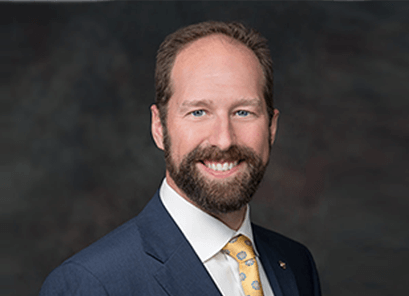There’s A Better Way To Talk About Investing
Micah Shilanski, CFP®, shares his scripts for discussing investments with clients and why portfolios based on emotional risk tolerance fail to deliver.
3.5 min read

Financial Planner, CFP®
“The reason you can’t get any clients is because your investments suck.” I know that stings, but so many advisors are going about investments all wrong.
Equally troublesome, advisors fail to frame investment conversations in a way their clients can understand.
I’m sure you get excited about investments—I do too—but that doesn’t mean your clients will be giddy over the stocks you cherry-picked for their portfolio. Your clients won’t care what’s in their portfolio as long as it meets their financial goals.
How to talk about investments with clients
Most of our job—if not all of it— should focus on finding ways to direct the client’s attention to what matters.
Our primary goal for retirees is to never run out of money. Secondary goals would include not getting killed in taxes, not getting killed by risk management, and not losing everything in estate planning.
However, advisors often drag clients through the weeds when discussing investments. Your clients aren’t interested in the nitty-gritty details of investing. They delegated their finances to you to help simplify their lives, not because they want to do it with you.

We see advisors barrel through Morning Star reports and investment performance reviews during client meetings instead of focusing on what matters: the client’s goals, estate planning, risk management, cash flow, and taxes.
Whenever you focus on discussing markets, investments, and performance, you’re saying these reports are more important than your client’s financial needs—which is absurd.
Advisors can’t keep clients because they’ve created an overly elaborate system that not only bores and confuses clients but doesn’t help them either.
You want to help your clients make informed decisions about their financial situation, but you can’t do that if you’re up to your elbows in portfolio performance reviews.
When you stress these reviews over actually talking about their financial goals, you’re telling them:
Hey, whatever past performances I dug up and the cherry-picked investments I found are much better than the cherry-picking anyone else could do.
And if that’s your value proposition, you’ll see clients pick advisory firms based on who had the nicest-smelling office or some other arbitrary criteria—odds are, they won’t pick you.
However, when prospects come to my office, Matthew Jarvis’, CFP®, office, or any of our INVICTUS members, we’ll ask them about their financial goals:
- How will you avoid overpaying in taxes?
- Do you have a plan for claiming social security?
- What’s your strategy for not overpaying taxes?
- How will you take income out of your nest egg?
No one else will ask your prospects these questions, and we’re widening the discussion to focus on the things that matter so we can guide them to tangible financial solutions.
Investments as a tool
When I meet with a client, I always ask what kind of cash flow they want through retirement, although this is just a gauge of how much money they’re spending. Once I know their cash flow, we start building out their portfolio.
Now, here’s where I do things differently from most advisors. I am looking at investments as a tool to help my client’s portfolio do its job. A portfolio’s job is to help provide an income that my client will never outlive.
Because I’m solving for a bigger picture, emotional risk tolerances aren’t a factor in my investment process.
Based on a client’s emotional risk tolerance, I could set something up, but it won’t meet their financial retirement goals. And if I guarantee their failure, what the heck am I even doing as a financial advisor?
Here’s how I explain my portfolio model to my clients:
Mr. and Mrs. Client, I’m not building an emotional portfolio. I’m making you a portfolio that will last your entire life—that’s what I’m going for.
I want you to know that I’m building up your portfolio so that we’re prepared to weather a great recession like we saw in 2008, but we also need to be prepared in case you live until 98.
I need to balance those two extremes, so I don’t do risk tolerances. I don’t do risk scores.
Now, if there’s something that we’re doing that keeps you up and up at night, where you’re fretting and can’t sleep, please pick up the phone and give me a call. We can reassess this.
Is that okay with you?
If the client and I can’t come together, and the portfolio selections they have to retire make them uncomfortable, maybe we’re not a good fit and need a graduation conversation.
However, emotionless portfolios usually aren’t a problem, especially when we can articulate their needs in a way they can understand.
Take a look:
Mr. and Mrs. Client, you’ve done a great job over the last thirty years. You’ve been building, you’ve been saving money in your 401(k), your TSP, and you’ve been buying investments. You’ve been able to see those accounts grow over your working career.
But where retirees make a big mistake is in saying, “What I’ve been doing over the last 30 years really worked for me. I will keep doing it for the next fifty years—everything should be the same.”
The difference is that you’re pulling money out instead of putting money in. And when you’re pulling money out, you’re really selling.
You’re selling, selling, selling. And that’s how retirees get devastated. They sell in down markets. How do you earn income that does not destroy your portfolio, even during a down market?
Now, Mr. and Mrs. Client, we want to ensure we can take income every month, no matter what the market is doing: good markets, bad markets, good presidents, bad presidents, high inflation, low inflation, etc.
Whatever it is, we’ve set aside five years of income to cover these distributions, no matter what the market does.
No one will talk to your clients about their feelings, what to expect when withdrawing from their nest egg, or if the market goes south.
You’ll miss a powerful opportunity to connect with your clients if you brush over these meaningful investment conversations to read the latest performance report.
Popular Topics
Value Adds
If you are routinely providing clients with value adds in a consistent, efficient, and deliverable
Still Holding Out on Surge™? 2023 Could Be Your Year
Micah Shilanski, CFP®, busts myths and misconceptions surrounding Surge meetings and shows how
Is That OK With You?
One of the most significant differences between ‘good’ advisors and rock-star level advisors is
Like Coke from a Coffee Mug: Run Your Best Client Meeting
Client meetings can be a dreaded part of a routine or you and your clients’ favorite part of your
5 Questions Every Advisor Should Ask
Matthew Jarvis, CFP®, answers five essential questions every advisor should ask to transform
What You Should
READ NEXT
10 Biggest Benefits of Hiring a Virtual Assistant
Micah Shilanski, CFP®, discovers the top 10 benefits of hiring a virtual assistant to enhance productivity, reduce costs, and boost employee happiness, making your business more efficient and
So What, Exactly, Is The Perfect RIA?
Micah Shilanski, CPF®, shares how The Perfect RIA transforms the financial planning industry by providing financial advisors with a real-world formula for
Don’t Miss Out On This Powerful Tax Strategy For Clients
Matthew Jarvis, CFP®, shares how backdoor Roth contributions can be a game changer for your clients and several ways advisors mess it
Start the change today!
Get our 3 most popular power sessions FREE. You and your team will learn about: Time Blocking, the One Page Financial Plan, and the “Buckets of Money” approach.



